We’ve been living off-grid since 2014. First in our little “maset”, an old donkey/horse stable that Axel (my wonderful and tech-savvy husband) converted into a tiny off-grid house. Then we house-sat our friends’ off-grid) villa during the winter. Finally, in May 2016, we moved into our own home/bed & breakfast between the olive and almond trees.
When we moved to Spain, our first objective was to be off-grid. That meant we’d have to collect water, generate power for electricity, generate heat, find ways to process waste and get internet without fibreglass. I like to think we’ve been successful so far; there is more work to be done (especially on the heating/hot tap water system and on the rainwater collection), but so far it all seems to work.
HOW it works though, was completely beyond me. So one day, as we went on a road trip to Cantabria, Axel tried to talk me through it… and I took notes. If you’re thinking about getting a solar system on your off-grid property, but are totally new to the concept of solar power, I hope this post will be able to help you.
If you’d like to know how our own house works at the moment, check out this page on our bed & breakfast website. Or, if you’d like a virtual tour of our off-grid home, you can take one here.
Although Axel has studied everything he could find on off-grid solar systems, he’s not an expert. Also, solar power depends on so many variables – anything from the dust on your panels to the temperatures in your area (which influence the efficiency of your battery). You can use this post as a first step to get you oriented, but I’d still recommend you seek the advice of a professional before buying.
This piece is all about setting up a solar system to live off-grid. We haven’t looked into putting up solar panels while being connected to the power grid (and maybe even getting paid to contribute to the grid). I’ve been told that’s a whole different thing – for starters, you don’t need batteries, which changes your whole setup. So if you’re looking for information about that kind of system… it’s not here.
Before We Start: Measures
Electrical consumption is usually measured in Watt (W). One kiloWatt (kW) = 1000 Watt. 1 kiloWatt-hour (kWh) = the amount of kW used by an appliance or tool if you use it for a full hour.
Sometimes an appliance doesn’t tell you how many Watts it uses, but measures consumption in Ampere; the formula to use then is Amps x Volts = Watts.
Peak Wattage (Wp) = how much Watt solar panels generate if the sun is at an optimal angle – which rarely happens (as the sun turns and it’s sometimes lower or higher). To be on the safe side, we multiply Wp (peak Wattage) by 0,7 to get a good estimate of the Wattage (W).
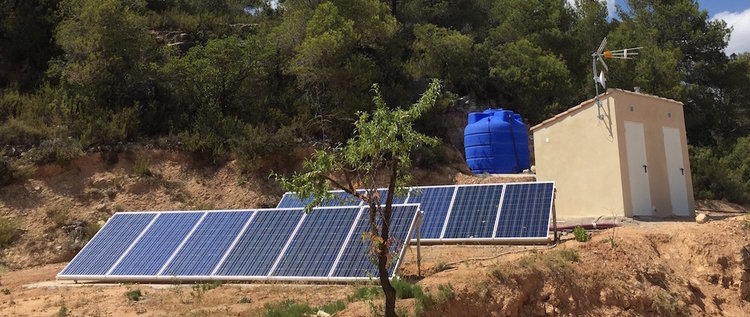
Defining Your Off-Grid Power Needs
1. What appliances will I have when I live off the grid?
Make a list of all your electrical appliances. The ones you have and are taking with you, and the ones you’d like to get once you live off-grid. For instance, we didn’t have incubators (to hatch chicken eggs) when we lived in the city. The same goes for the water pump, pressure pump, certain power tools… Living off-grid, you can use as little or as much electricity as you like. You can watch your consumption like a hawk, or switch on electrical appliances like there’s no tomorrow. You can have dozens of devices on stand-by all day, or be careful to switch off things completely in between uses. Your lifestyle should determine the size of your solar system.
2. How can I save on usage?
Are there any old appliances I could switch for new, more energy-efficient ones?
Older appliances often use a lot of power. Check on things you’ll be using a lot (like the fridge, for instance – buying a new fridge could be cheaper than getting a more powerful solar system to sustain your old fridge).
Are there any appliances that use a lot of electricity, and would it cost me a lot less if I had them working on fuel?
For instance, most off-grid people living around here have an oven working on gas. We aim to be fossil fuel free one day, so we got an electric oven, and I don’t bake as much on cloudy days. Many people have their water pump working on a generator only; our pump is connected to the solar system, and will only use the generator when the batteries are not full enough (or when we switch it on manually).
Are there any appliances that I could switch for a more durable alternative?
You could build a root cellar to keep food fresh all year round, build a cob oven for pizza and bread, get or build a solar drying oven or connect the hot tap water to your stove in winter… The possibilities are endless.
Are there any appliances I could do without?
In our move to Spain, I lost my hairdryer, and I only found it again two years later. In the meantime, I didn’t miss it… The same goes for the water cooker that was stuck in a box somewhere – we used a kettle instead and never looked back. We chose not to get air conditioning; the plan was to have ample overhang so no sun would come in during the summer, and we have quite a lot of thermal mass too. This is a question of comfort vs bare needs – what are you willing to do without? Take a look at your computers as well. A desktop computer uses so much energy compared to a laptop! If your computer needs replacing anyway, it’s worth looking around.
Don’t forget the lights! Think about how many lights you’ll need for every room. Consider getting energy-saving lightbulbs or (better) LED; they are available in a wide range of color tones (from hard blue-ish to soft yellow) and brightness.
As a general rule, consider this:
A small effort in energy conservation or energy saving can save you lots of money on the cost of your energy generation equipment. You’ll have to consider if there’s anything you’re willing to give up in order to be more energy-efficient. If you’re not, that’s fine! You’ll just need a bigger system.
However, look at the long-term costs as well: for example, a propane fridge might save you a bit on the acquisition of the solar system, but you’ll have to keep buying propane.
3. Make good use of what you have
Use what you have efficiently, so you don’t need more appliances than is strictly necessary. We have friends who use their fridge only in summer when it’s not too demanding on the solar system. In winter, anything that needs to be kept cool goes outside. We have a cellar that has a pretty constant temperature, summer and winter, which is perfect for storage of fruit and vegetables so we don’t need such a big fridge.
4. List how much each appliance consumes
Once you have your list of appliances, write down how much each of them consumes. Make an extra note for the ones you will need/want to use all year round (I really don’t need my dehydrator or an extra freezer in winter). Don’t think you’ll only wash clothes on sunny days; it might be unexpectedly foggy for weeks.
5. How to calculate your daily needs
Make a list of all your appliances, and note how much power each one uses. How many hours a day will it be on – will it need to work 24/7 (like a fridge), or will you use it for 30 minutes a day (like a vacuum cleaner)?
Multiply the usage (in W or kW) by the number of hours you will use it, to work out how much energy an appliance consumes per day.
For instance, if a vacuum cleaner uses 2000W (= 2kW) and you use it for 30 minutes, you used 1kWh.
You could use this to get an estimate of what you’ll consume. Don’t forget to change the Wattage on your appliances though if you’ll have more (or less) energy-efficient ones!
Now we know how much power we’ll be using every day (X), it’s time to look at what we need in order to live that kind of lifestyle.
The Battery Bank For An Off-Grid Solar System
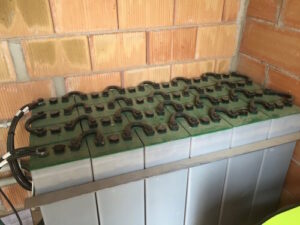 How much time do I want to survive on battery power if there’s no sun?
How much time do I want to survive on battery power if there’s no sun?
This is entirely your choice. We chose to be able to draw power from the batteries for 3 full days when it’s rainy or foggy before the generator would need to save us from powerlessness. In normal years, we don’t get more than two consecutive days of fog; occasionally we’ve had an exceptionally foggy winter though, where the generator kicked in a few times.
The amount of kWh you want to use every day x the number of days you’d like to survive on batteries alone x 2 = the (approximate) total battery capacity you’ll need.
You multiply the total battery capacity by two, as most kinds of batteries can’t be discharged for more than half (there are exceptions, like lithium-ion batteries, but these are still quite expensive).
What’s your Battery Capacity?
Battery capacity is not specified in kWh, but in Amp-hours (Ah). This is the amount of Amperes your house grid will suck from the batteries in an hour.
The specs of the batteries mention this in different discharge times:
- C10 = the amount of Ah that is taken from the batteries if you empty the batteries in 10 hours (= when you’ve got a lot of appliances running at the same time).
- C100 = the amount of Ah that is taken from the batteries if you empty them in 100 hours (= if you’re using as little energy as possible).
Calculation Example: we wanted to use about 6kWh per day x 3 days x 2 = we needed an approximate battery capacity of 36 kWh.
Our Battery Array
We got a battery array of 48 volts, and each of our batteries is 750 Ah (calculated on C10) to 975 (calculated on C100).
Calculation: 48V x 750Ah = 36000 Wh (= 36 kWh), if we’re using all of our appliances at once. 48V x 975Ah – 46800Wh (give or take 47kWh) if we’re being very prudent with our electricity in winter. So if you look back at the calculations above (we think we need the batteries to be able to store 36 kWh), you will see that this is just enough if we’re using all of our appliances at once (they’d produce 36 kWh).
However, it’s plenty to live on for three days, if we don’t use the “big consumers” much during those dark or foggy days.
Inverter & Charge Controller
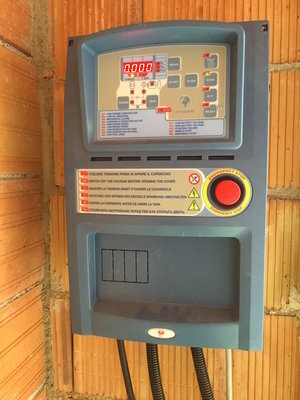
The inverter converts what’s coming out of your batteries into a voltage suitable for use (in our case, this is 220-240 volts). It will define how much maximum power (6kW, 8kW) can be used at the same time before it trips (for instance, do you want to be able to use your vacuum cleaner, hairdryer and dishwasher at the same time? – if so, you might want a more powerful inverter). Our inverter is 8kW.
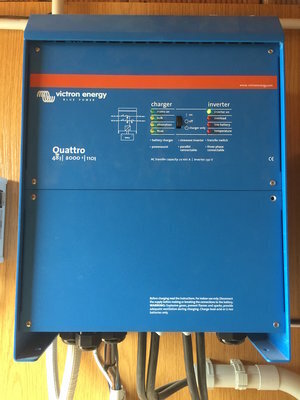
The charge controller is usually part of a set with the inverter. It controls how the batteries are charged by the solar panels. A good charge controller will make sure the energy collected by the panels will be stored efficiently in the batteries.
Solar Panels
Polycrystalline or monocrystal?
The difference between the two is efficiency. Mono is more efficient than poly, but an array of poly can work when a part of the array is in the shade (while with mono, a bit of shade on one of the panels will stop all power generation). So if you have any shade falling on your panels at certain times of the day, choose polycrystalline panels.
How many panels?
The number of panels depends on how much your batteries can store. You don’t want too few (they should be able to fill the batteries on a good sunny day, preferably in a few hours), and having too many is a waste (once the batteries are full, they’re full)!
When getting your solar panels, try to do it right the first time; it’s complicated to add extra panels once your system is operational. A typical solar panel will charge between 200 and 300 Wp (0,3 kWp or kiloWatt peak). That means that under perfect (laboratory) conditions, it could generate 200 to 300 Watts per hour.
The formula to calculate how many panels you need is (the amount of energy you think you’ll consume in total during the darkest month of the year, in kW) x (average sun hours per day in that month, in hours). Then divide that number by 10, and you’ll have an estimate of the number of panels you’ll need. For us, this is 186kW (6kW x 31 days) x 4 (amount of sun hours in December in Teruel) / 100 = 7,44.
This means we need at least 8 panels – and that would only be able to provide us with our daily needs, not charge the batteries. That’s why we chose to have 12 panels. Our 12 panels generate about 2,5 kW (they are 300PV (peak voltage) panels so 12 x 300 x 0,7 = 2,5 kW). On a good day, they will charge about 16 kWh.
Amount of panels x Wp per panel x 0,7 = kW your solar panel array might be generating in optimal circumstances.
Amount of sun (sun days/sun hours)
To put it simply, you’ll need more solar panels if you live in a place with fewer sun hours. The average sun hours in the darkest month for your country or region should tell you a lot. If your region doesn’t get much sun in winter, consider adding alternative power sources. A windmill or a water mill might be a good choice to provide you with electricity on sunless days.
There is the option of getting rotating panels; a solar tracker will make sure the panels always face the sun, so their angle is more optimal and they absorb more solar energy. This way, you’ll need fewer solar panels. However, the mechanism to rotate your panels costs money as well. We have friends with rotating panels living around here (and they’re very happy with them and think they’re worth the investment), but we have chosen static panels for our own system.
Generator
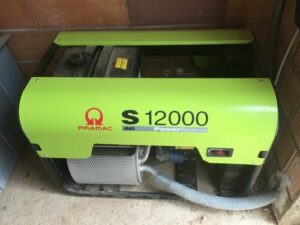 What is the purpose of my generator?
What is the purpose of my generator?
The first purpose of our generator is to charge the batteries when there’s not enough sun. When it’s on, it will supply power to the house first – whatever we’re not using at that moment, then goes straight into the batteries.
The second purpose of our generator is to provide us with a backup power source in times of crisis – when the solar system isn’t working for some reason.
Some people choose to use their generator for other purposes as well – we have friends in the area who put on the generator for pumping water, for using certain appliances or power tools – this is probably cheaper (even in the long run) than getting a bigger solar system.
However for us, money was not the only thing we looked at – we aim to be (as good as) fossil fuel free one day, so we try not to rely heavily on the generator.
How big should my generator be?
How long do you want your generator to run in order to charge your batteries? A bigger generator will need less time to charge them (but it’ll be more expensive to buy). If you’re planning to run certain machines (like a water pump or wood chipper) directly on the generator, you will need to make sure the generator is big enough to handle this.
The power output of the generator won’t charge into your batteries for 100% (usually about 70%). The inverter makes sure of that. Take that into account when calculating the kind of generator you need. Our generator has a peak power of 12kW, but continuous power of 9kW.
Should my generator switch on automatically?
In our solar system, we have included a switch so that if the batteries run low, the generator will switch on automatically. It just makes life easier and more relaxed, we don’t have to keep an eye on the battery level to see if we need to manually switch on the genny.
Diesel or petrol?
Diesel generators are generally more fuel-efficient, they cost less to run and last longer (they don’t have to work as hard as petrol engines to get the same power output). However, although they are less likely to fail, they are often more expensive to fix when they do. Petrol generators have been around for longer so there is more choice of models and options (especially for home use, like ours).
These were the consideration we made before we purchased our solar off-grid system. I say “we”, but I just made lists of appliances and looked for more energy-efficient ones, while my husband did the calculations and compared options. As I said above, we’re very happy with our system so far. If you’re in the neighborhood, you’re very welcome to drop by and get a tour (make an appointment first so we can make the time to show you around properly!).
Hopefully, this post gave you a helpful introduction to some things you need to consider when setting up your off-grid solar system. If you’d like to learn more (in a really non-techy and straightforward way), we wrote an ebook to help you do that! And you can get your copy here.
If you’re preparing to start a new life off-grid, you might enjoy our PDF download – what to do before you move off-the-grid.
Now, over to you – we’d love to hear about your solar power setups. What system do you have or are you looking at?

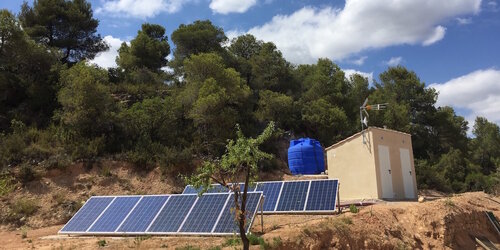

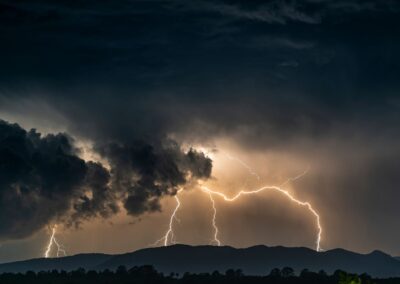



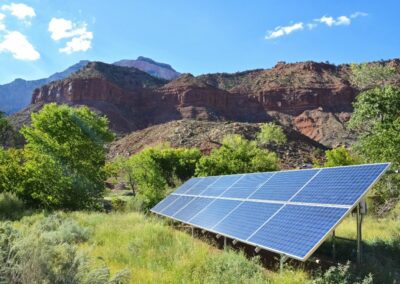

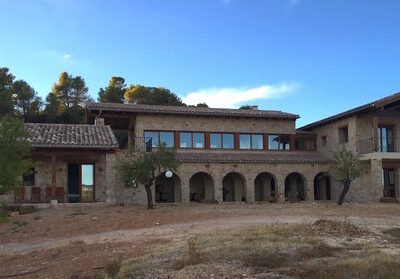

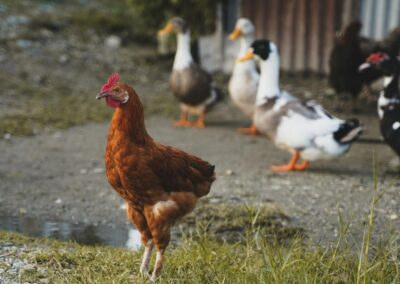
0 Comments